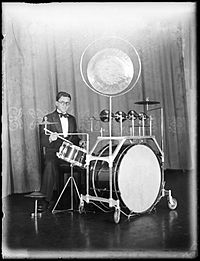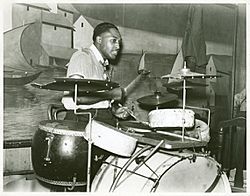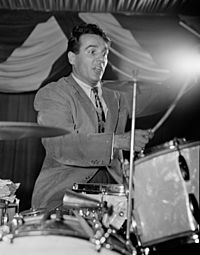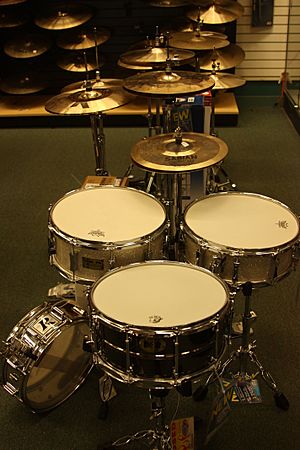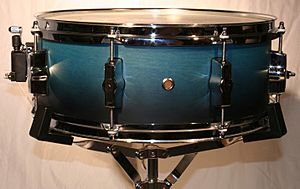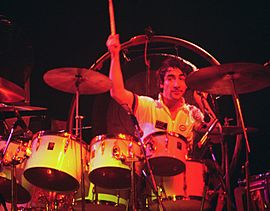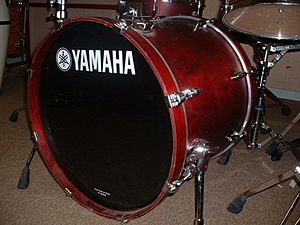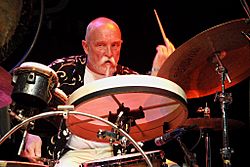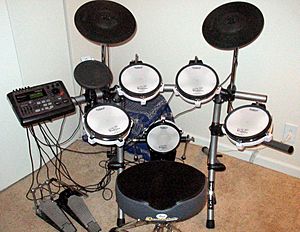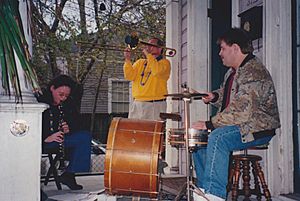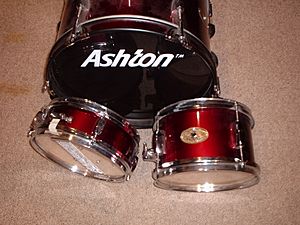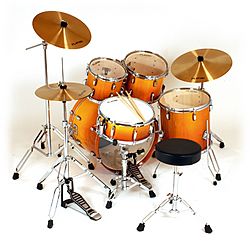Drum kit facts for kids
A drum kit (also called a drum set or trap set) is a group of drums, cymbals, and other percussion instruments. A drummer uses it to play music in a musical group.
A drum kit usually has these main parts:
- Bass drum - This is the biggest drum. You hit it with a special hammer by pressing a pedal with your foot. Drummers often use it to start musical sections and keep the main beat. It's sometimes called a kick drum.
- Snare drum - This drum has small metal wires stretched across the bottom. These wires make a loud, sharp "tat" sound when you hit the top.
- Tom Toms - These are usually two drums placed on top of the kit. The smaller tom makes a higher sound, and the medium tom has a slightly lower sound. Drummers can have many toms, like an 8-inch tom for a very high sound, often used in jazz.
- Floor Tom - This tom sits on its own legs next to the drummer. It makes a lower sound than the other toms, usually the second lowest after the bass drum. Floor toms are often 14 to 18 inches big.
- Hi-hat - These are two cymbals of the same size. You can hit them together using a foot pedal, or strike them with a drumstick. Hi-hats help keep the beat and add rhythm. You can play them open, closed, or partly open. They are very important cymbals on the kit.
- Crash Cymbal - This cymbal makes a loud "crash" sound. The sound changes depending on the brand. Drummers use crash cymbals to mark important parts of a song, like the start of a new section or to add emphasis.
- Ride Cymbal - This is a large, heavy cymbal that usually makes a light, airy sound. Drummers "ride" on it to keep time, especially during choruses or bridges, because its sound stands out more than the hi-hat. You can also hit the bell (center) of the ride cymbal for a clear, ringing sound. It's often considered the second most important cymbal after the hi-hats.
Drummers can add other cymbals for more sounds. A Splash cymbal is small (around 10 inches) and makes a quick crash sound that fades fast. A China cymbal gives an "oriental" sound. It looks like a crash cymbal turned inside out.
Drummers can also attach other instruments to their kit. For example, a tambourine can be attached to the hi-hat stand. When the drummer uses the hi-hat, the tambourine also plays. A cowbell can be added to the bass drum for special rhythms and solos.
Contents
History of Drum Kits
How Drum Kits Started
A long time ago, in the 1800s, if a band needed a bass drum, cymbals, and a triangle, they would hire three different people to play them. But in the 1840s, drummers started trying out foot pedals so they could play more than one instrument at once. By the 1860s, drummers began putting different drums together into one set.
In musical theater, where money for musicians was often tight, drummers found ways to do the job of many percussionists. This helped create the drum set. Drummers learned to play the bass drum and snare drum with sticks, while using their foot to tap a cymbal on a "low-boy" stand. This way, one person could play many instruments.
This new way of drumming led to ragtime music, which had a fun, dance-like feel. The drum set was first called a "trap set," and drummers were called "trap drummers" until the 1930s. In 1909, the Dickson & Dickson Co. made the first successful bass drum pedal, which was a big step towards the modern drum kit.
Around 1912, wire brushes were invented for drums and cymbals. Drummers needed them to play more quietly so the drums wouldn't be too loud compared to other instruments on stage.
Drum Kits in the 20th Century
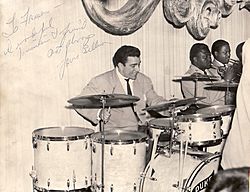
By World War I, drum kits often looked like marching band bass drums with many other percussion items hanging around them. Drum kits became very important in jazz music, especially Dixieland jazz. The modern drum kit really grew in the 1920s in New Orleans. Drummers like Baby Dodds started mixing marching rhythms with ragtime to create a new jazz drumming style.
The "trap" in "trap set" came from a tray on top of the drum console. This tray held items like whistles, klaxons, and cowbells. Hi-hat stands became available around 1926.
Baby Dodds was a key drummer who changed how drums were played. He started hitting cymbals with sticks, which was new. He also added a side cymbal above the bass drum, which became the ride cymbal. He helped develop the modern hi-hat cymbal by asking for the "low hats" to be raised higher.
In the 1920s, drummers also worked as "foley artists" for silent films. They would play instruments to make sound effects like gunshots or train sounds. But when "talkies" (films with sound) came out around 1927, many drummers lost these jobs.
Big Band Drumming
In the 1930s, big band swing music became very popular, partly thanks to the radio. The drum kit was a big part of the swing sound. Drummers like Chick Webb and Gene Krupa made their drum kits look and sound amazing. Jazz drummers helped create the modern drum kit and new ways of playing. Gene Krupa was one of the first drummers to lead his own orchestra and make drum solos famous.
During this time, more drums and cymbals were added, like tom-toms, small crash cymbals, and Chinese cymbals. The hi-hats became the main way for big band drummers to keep time. Before 1930, drummers would mute cymbals with their hands to keep time. This was awkward, so they invented foot-operated cymbals, which led to the hi-hats we know today. By the 1930s, a basic four-piece drum set became standard: bass, snare, tom-tom, and a larger floor tom.
Bebop Drumming
In the early 1940s, some jazz musicians created a new style called bebop music. Unlike swing, which was for dancing, bebop was for listening and had faster tempos and more improvisation.
Bebop drummers like Max Roach and Kenny Clarke started using smaller bass drums because the big marching band drums were too loud. They also began keeping time on the new, larger ride cymbal instead of the bass drum. This made the drumming feel lighter and more melodic. Louie Bellson also helped by being one of the first to use two bass drums.
Rock Drumming
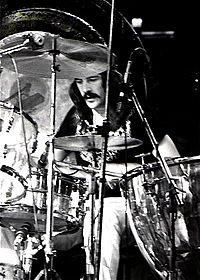
When rock and roll became popular in the 1960s, drum kits started getting bigger. Drummers like Ringo Starr of The Beatles showed off their kits on TV. In the 1970s, progressive rock led to even larger drum kits. By the 1980s, famous drummers like Neil Peart used many drums and cymbals. Some drummers also started using electronic drums.
Today, drummers might add electronic sound modules, laptops for loops, or even unusual objects like buckets to their kits for unique sounds.
Recording Drums
In early recordings (before 1925), drummers had to sit far away from the recording equipment to avoid making too much noise. This made cymbals sound bad, so sound engineers asked drummers to play on woodblocks, temple blocks, and cowbells instead, because they were louder and had a shorter sound.
Parts of a Drum Kit
Terms You Might Hear
Breakables, Shells, Extensions, Hardware
A drum kit can be thought of in four parts:
- Breakables: These are the parts drummers often bring themselves, like sticks, cymbals, the snare drum, their stool (throne), and sometimes the bass drum pedal.
- Shells: This means the bass drum and the tom-toms.
- Extensions: These are extra instruments added to the kit, like a cowbell, tambourine, or chimes.
- Hardware: This includes all the stands for cymbals and drums, and pedals.
Drummers often bring their own "breakables" because these parts are very personal to their playing style. The snare drum and cymbals especially have a unique sound for each drummer. They are also the parts that get played the most and can break if not handled carefully.
Drum Sizes
Drum sizes are usually given as depth x diameter or diameter x depth in inches. For example, a tom that is 8 inches deep and 12 inches across might be called 8" x 12" or 12" x 8" depending on the company.
Drums
Snare Drum
The snare drum is super important, especially in rock music, because it plays the main backbeat. It makes a sharp, buzzing sound because of the metal wires (snares) stretched across its bottom head. When you hit the top head, the snares vibrate, creating that special "snap."
Toms
Tom-tom drums, or toms, are drums without snares. Drummers use them for most drum fills and solos.
Types of toms include:
- Traditional double-headed rack toms: These are mounted on stands or the bass drum.
- Floor toms: These are usually the biggest and lowest-pitched toms, sitting on the floor on legs.
- Single-headed concert toms: These only have one drumhead.
- Rototoms: These drums have no shell and can change pitch by rotating them.
The number of toms often gives a drum kit its name, like a "five-piece" kit, because the snare and bass drum are always there.
Bass Drum
The bass drum (or "kick drum") provides the deep, low foundation for the rhythm. It usually keeps the main beat. Some drummers use two bass drums or a special double pedal with one bass drum to play faster rhythms, especially in heavy metal music. Using a double pedal saves space and makes it easier to set up.
Other Drums
Octobans are small toms, usually 6 inches wide, that extend the tom sound to higher pitches. Timbales are also used by some drummers to add higher sounds, though they are usually played with lighter sticks. Gong drums are rare, large single-headed drums (like a bass drum) used as a very low floor tom.
Cymbals
Cymbals are just as important as drums in most kits. The first cymbals were used thousands of years ago. Today, the company Zildjian has been making cymbals since 1623 in Turkey.
Beginner cymbal sets usually have four cymbals: one ride, one crash, and a pair of hi-hats. Many drummers quickly add more, like another crash, a splash, or a china cymbal.
Ride Cymbal
The ride cymbal is often used to keep a steady rhythm, playing on every beat or more often. Most drummers have one main ride cymbal, usually 20 inches wide, placed near their right hand. It's often a heavy cymbal so its sound stands out.
Hi-hats
Hi-hat cymbals (or "hats") are two cymbals facing each other on a stand. They have a foot pedal. When you press the pedal, the top cymbal moves down to meet the bottom one. When you lift your foot, they separate. You can hit them with sticks or just use the pedal to make sounds.
You can make different sounds by hitting "open hi-hats" (cymbals apart for a noisy sound) or "closed hi-hats" (cymbals together for a crisp sound). You can also hit an open hi-hat and then close it with your foot for a cool effect, often used in disco and funk music. The hi-hats are used to keep faster rhythms in a song.
Crashes
Crash cymbals are used to mark strong accents in music, like at the start of a new section or to show a big change in the song. Drummers often hit the crash cymbal at the same time as the bass drum for a bigger sound.
Some ride cymbals can also be used as crashes, especially in jazz or at loud volumes. There are also special crash/ride cymbals designed to do both jobs.
Other Cymbals
Effects Cymbals
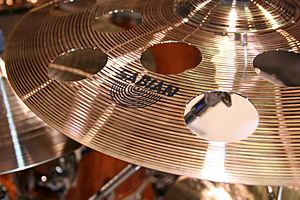
Any cymbals other than rides, hi-hats, and crashes are usually called effects cymbals. Most drum kits with extra cymbals will have one or more splash cymbals (small, quick crash) and at least one china cymbal (oriental sound).
Accent Cymbals
Cymbals used to make a quick, strong accent rather than a regular rhythm are called accent cymbals. These can include small-bell cymbals or those with a clear, ringing sound.
Other Acoustic Instruments
Drummers often add other instruments to their kits:
- Wood blocks and cowbells: Common in classic rock and other music styles.
- Tambourine: Often mounted on the hi-hat stand.
- Timbales: Can be used to add higher-pitched tom sounds.
- Xylophone or glockenspiel: For melodic sounds.
- Gongs or Bar chimes: For special effects.
- Triangles.
- Found objects: Anything that can be hit to make a sound, like wrenches or buckets.
Electronic Drums
Electronic drums are used for many reasons. They are great for playing in small places like coffee shops or churches where you need quiet music. Since electronic drums don't make much sound on their own, all the drum sounds come from speakers, so you can control the volume easily.
Many drummers use electronic drums for practice because they can listen with headphones. This means they can practice late at night without bothering anyone. Electronic drums also offer a huge range of sounds, from real drum sounds to electronic sounds and even sounds like ocean waves.
Setting up electronic drums is often faster than acoustic drums. They also weigh less and take up less space to move around. However, some drummers feel they don't have the same "feel" as acoustic drums.
Drummers can use electronic drums in different ways:
- Adding one electronic pad to an acoustic kit for a special sound.
- Mixing acoustic drums and cymbals with electronic pads.
- Using triggers on acoustic drums and cymbals to make electronic sounds.
- Using a full electronic kit with rubber or mesh pads.
Electronic drum pads are like controllers for computers or sound modules. When you hit a pad, it sends a signal to a "drum brain" (a sound module) that plays a sound. This sound can be anything from a drum to a barking dog!
Virtual Drums
Virtual drums are computer programs that copy the sound of a drum kit. They use recorded sounds of real drums or made-up sounds. Some programs let you record your playing, choose different drum kits (like jazz or rock), and even play along with songs. You can even find virtual drumming apps for phones and tablets.
Common Drum Kit Setups
Drum kits are usually named by the number of drums they have, not counting cymbals. The snare, tom-toms, and bass drum are always counted.
The sizes below are typical, but drummers often change them.
Three-piece Kit
A three-piece drum set is the most basic. It usually has a bass drum, a 14-inch snare drum, 12-14 inch hi-hats, one 12-inch hanging tom, and one suspended cymbal (14-18 inches). These kits were popular in the 1950s and 1960s and are still used in small bands. They are also common for children's drum kits.
Four-piece Kit
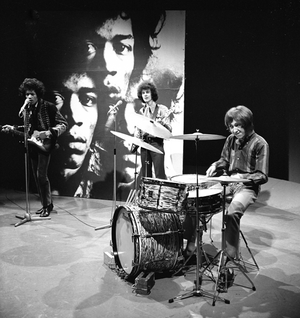
A four-piece kit adds one more tom to the three-piece set. This can be a second hanging tom or a floor tom. Usually, another cymbal is added too, so you have separate ride and crash cymbals. Common cymbal sizes are a 16-inch crash and an 18-20 inch ride.
Four-piece with Floor Tom
If a floor tom is added, it's usually 14 inches for jazz or 16 inches for other styles. This setup is common in jazz, classic rock, and rock and roll. Famous drummers like Ringo Starr used this kind of kit.
Four-piece with Two Hanging Toms
If a second hanging tom is used, it might be a 10-inch tom (for fusion music) or a 13-inch tom. Both toms are usually mounted on the bass drum, with the smaller one on the left (for right-handed drummers). These kits are good for smaller places like coffee shops.
Five-piece Kit
The five-piece kit is the most common setup. It adds a third tom, giving you three toms in total. A "fusion" kit might have 10-inch, 12-inch, and 14-inch toms. Having three toms gives drummers more choices for fills and solos.
Other five-piece kits might have 12-inch and 13-inch hanging toms, plus a 14-inch or 16-inch floor tom. Today, 10-inch and 12-inch hanging toms with a 16-inch floor tom are very popular. The bass drum is usually 22 inches, but can be bigger for rock or smaller for jazz. A second crash cymbal is also common.
Most five-piece kits also have one or more effects cymbals. Digital drum kits are often sold as five-piece sets, with plastic pads that trigger electronic sounds.
Small Kits
If you take away all the toms, or replace the bass drum with a pedal on a floor tom, you get a two-piece "cocktail" kit. These are popular in music styles like trad jazz and rockabilly. Some rockabilly kits even skip the hi-hat stand so the drummer can play standing up.
Smaller drum kits are also made for specific uses, like "boutique" kits that look less bulky, "traveling" kits that are easy to carry, and "junior" kits for young players. Smaller drums are also quieter, which is good for small venues or practicing quietly.
Extended Kits
Drummers can add many things to their standard kits:
- Effects cymbals like splash cymbals and china cymbals.
- Double bass drums or a double bass pedal, common in heavy metal.
- More hanging or rack toms.
- More crash cymbals.
- A crash/ride cymbal in addition to the main ride.
- A second, different-sized floor tom.
- Octobans or mini timbales.
- A second pair of hi-hats.
- Cymbal stacks (cymbals piled on top of each other).
- Gongs.
- More ride cymbals.
- Some electronic drums mixed with acoustic ones.
Less common additions include multiple snare drums, more than two bass drums, gong drums, or even instruments from orchestras like timpani.
Drum Kit Accessories
Sticks
The most common drumsticks are made of wood. They come in different weights and tip designs. For example, a 7A stick is light and good for jazz, while a 5A is heavier and common for rock. The numbers usually mean lighter sticks as the number gets higher.
The exact meanings of the numbers and letters can change between brands. Sticks can also be made from aluminum, acrylic, or graphite. Other types of sticks include rutes (bundles of canes) and wire or nylon drum brushes. Some drummers even use the "wrong" (butt) end of a stick for a heavier sound.
Muffles
Drum muffles are used to change the sound of a drum, making it less ringing or quieter. This is helpful in studios or live shows to make sure the drum sound mixes well with other instruments. Muffles can be placed inside or outside the drumhead.
Common muffles include rings, gels, duct tape, or even a wallet placed on the drumhead. Some drums have built-in mufflers, but external ones are often more effective.
For the bass drum, pillows or sleeping bags are often placed inside to muffle the sound. Cutting a small hole in the front head can also help.
Silencers/Mutes These are rubber pads that fit over the entire drumhead or cymbal. They stop the stick from hitting the head directly, making the sound much quieter. They are great for practicing silently.
Cymbals are usually muted by hand to stop them from ringing too long. Special rubber rings or duct tape can also be used.
Stick Holder
Stick holders are bags or angled tubes that attach to your drum kit. They let you keep extra drumsticks close by.
Sizzlers
A sizzler is a metal chain that hangs across a cymbal. When you hit the cymbal, the chain vibrates and makes a "sizzling" sound, like a sizzle cymbal. This is a way to get that sound without drilling holes in your cymbal to add rivets. You can also easily remove the sizzler if you don't want the effect.
Cases
There are three main types of covers for drum kits:
- Drum bags are made of strong cloth. They protect drums from rain and small bumps, good for local gigs.
- Mid-price hard cases are stronger, like suitcases, and offer more protection from impacts.
- Flight cases are the strongest cases, used by professional drummers who travel a lot.
The best protection for drums is a hard case with soft padding inside.
Microphones
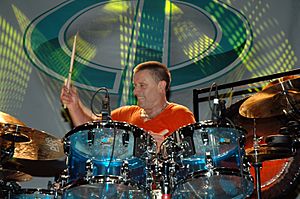
Microphones (or "mics") are used to pick up the sound of drums and cymbals for sound recording or to make them louder through a PA system (speakers). Most drummers use mics for live shows so the sound engineer can control the volume and mix of each drum.
In small venues or for quiet music like jazz, bands might play without mics. But for bigger shows, drums are usually miked. Dynamic microphones are often used close to drums because they can handle loud sounds. Condenser microphones are used for overhead mics to capture the whole kit sound.
Mics can be on stands or attached to the drum rims. Sometimes, mics are even built into the drums. Sound engineers can also add reverb or digital delay effects to the drum sound. Some drummers bring their own mics to make sure they have good quality sound.
Monitors
Drummers using electronic drums or a mix of acoustic and electronic drums often use a monitor speaker or a small PA system to hear their electronic sounds. Even acoustic drummers might use a monitor, especially in loud rock bands, to hear their own drums over the other instruments.
Drummers often get a large speaker with a subwoofer to help them hear their bass drum sound. Some drummers use a "butt shaker" or "throne thumper" which makes the drum stool vibrate with each bass drum hit. This way, the drummer feels the beat, which can help keep the stage volume down.
Bass Drum Gear
There are accessories just for the bass drum. Patches protect the drumhead from the beater. Bass drum pillows or old sleeping bags can be put inside the drum to change its sound or make it less resonant.
Gloves
Some drummers wear special gloves to get a better grip on their sticks. These gloves often have a textured surface and vents to keep hands cool.
Drum Screen
In some places, like churches or small venues, or when recording, drummers might use a clear plastic drum screen (or drum shield). This helps to lower the sound of the drums on stage. A screen that goes all around the kit is called a drum booth. Drum screens help the audio engineer control the drum volume for the audience and reduce overall band volume.
Carpets
Drummers often bring a carpet or rug to gigs. This stops the bass drum and hi-hat stand from "crawling" (moving away) on slippery floors. The carpet also helps reduce echoes and protects the venue's floor. Bass drums and hi-hat stands often have spikes or rubber feet to help them stay in place.
Practice Equipment
Drummers use different tools for practicing. Metronomes help them keep a steady beat. Drum muffling pads make drums quieter. A practice pad is a small rubber pad used for almost silent practice with sticks. A set of practice pads that looks like a drum kit is called a practice kit. Today, electronic drums are often used for quiet practice with headphones.
Tuning Equipment
Drummers use a drum key to tune their drums and adjust hardware. The most common drum key is a T-shaped wrench. There are also special wrenches and tools for high-tension drums or for changing heads quickly. Tension gauges can be placed on the drumhead to help drummers tune consistently. Drummers can tune "by ear" or use digital drum tuners for very accurate tuning.
Images for kids
See also
 In Spanish: Batería (instrumento musical) para niños
In Spanish: Batería (instrumento musical) para niños


